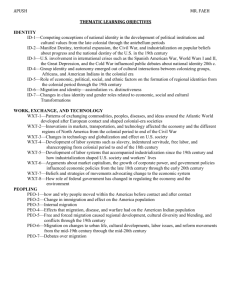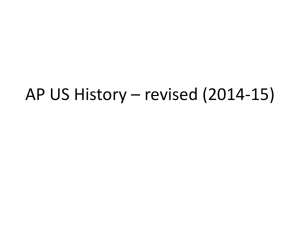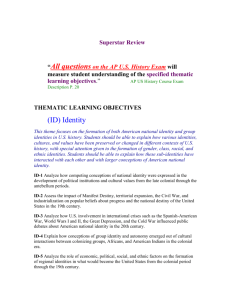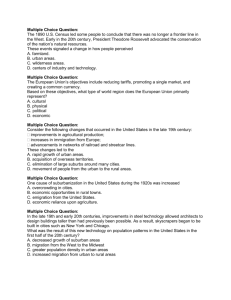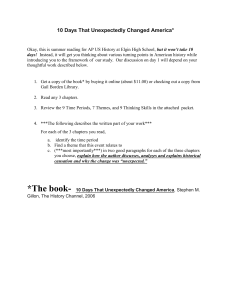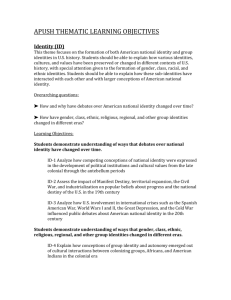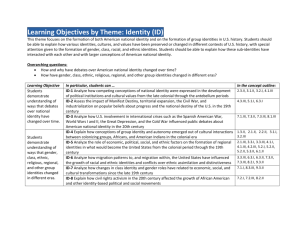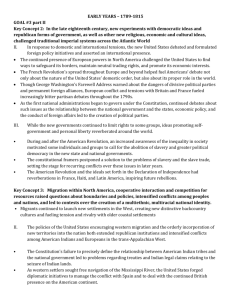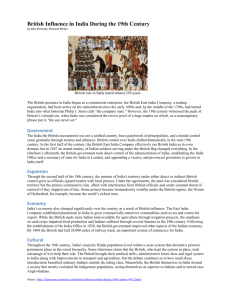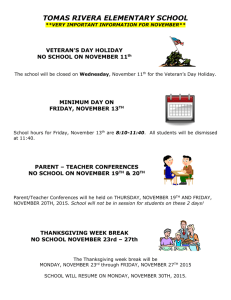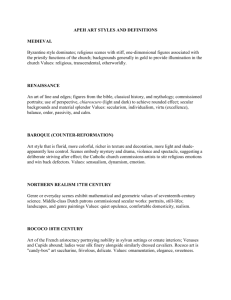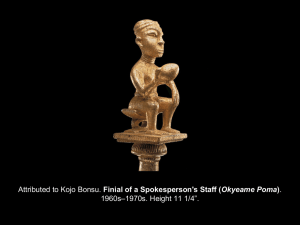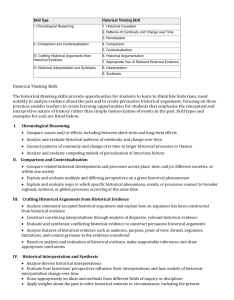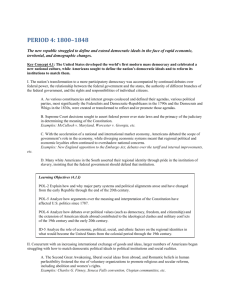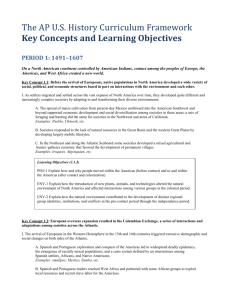File
advertisement
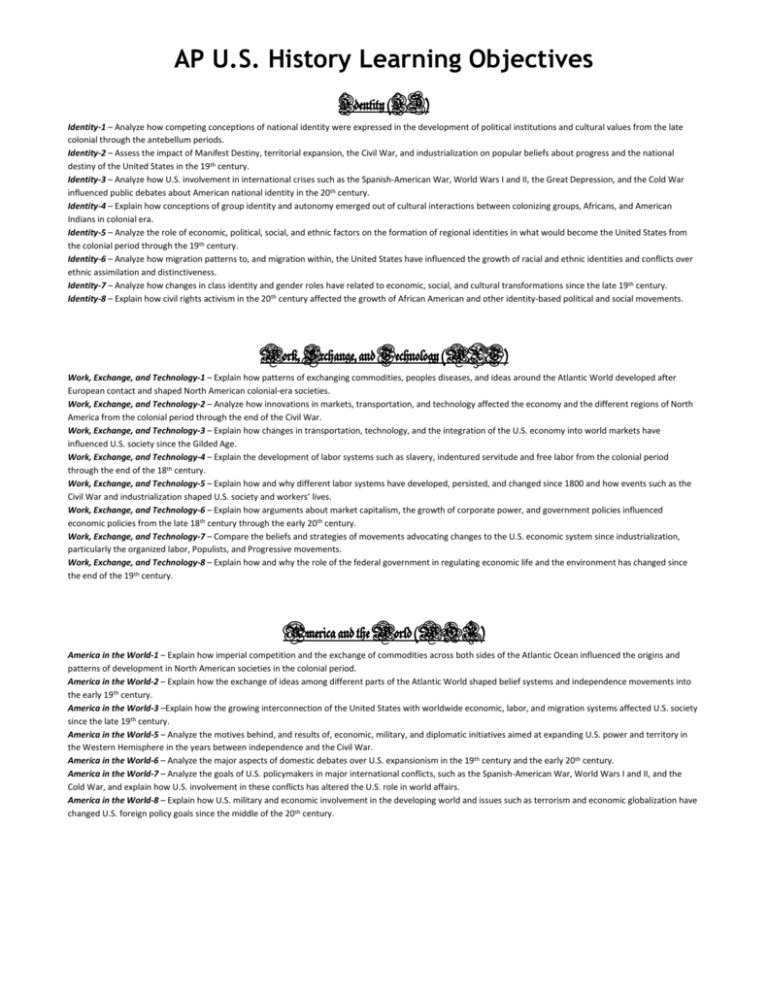
AP U.S. History Learning Objectives Identity (ID) Identity-1 – Analyze how competing conceptions of national identity were expressed in the development of political institutions and cultural values from the late colonial through the antebellum periods. Identity-2 – Assess the impact of Manifest Destiny, territorial expansion, the Civil War, and industrialization on popular beliefs about progress and the national destiny of the United States in the 19th century. Identity-3 – Analyze how U.S. involvement in international crises such as the Spanish-American War, World Wars I and II, the Great Depression, and the Cold War influenced public debates about American national identity in the 20th century. Identity-4 – Explain how conceptions of group identity and autonomy emerged out of cultural interactions between colonizing groups, Africans, and American Indians in colonial era. Identity-5 – Analyze the role of economic, political, social, and ethnic factors on the formation of regional identities in what would become the United States from the colonial period through the 19th century. Identity-6 – Analyze how migration patterns to, and migration within, the United States have influenced the growth of racial and ethnic identities and conflicts over ethnic assimilation and distinctiveness. Identity-7 – Analyze how changes in class identity and gender roles have related to economic, social, and cultural transformations since the late 19th century. Identity-8 – Explain how civil rights activism in the 20th century affected the growth of African American and other identity-based political and social movements. Work, Exchange, and Technology (WXT) Work, Exchange, and Technology-1 – Explain how patterns of exchanging commodities, peoples diseases, and ideas around the Atlantic World developed after European contact and shaped North American colonial-era societies. Work, Exchange, and Technology-2 – Analyze how innovations in markets, transportation, and technology affected the economy and the different regions of North America from the colonial period through the end of the Civil War. Work, Exchange, and Technology-3 – Explain how changes in transportation, technology, and the integration of the U.S. economy into world markets have influenced U.S. society since the Gilded Age. Work, Exchange, and Technology-4 – Explain the development of labor systems such as slavery, indentured servitude and free labor from the colonial period through the end of the 18th century. Work, Exchange, and Technology-5 – Explain how and why different labor systems have developed, persisted, and changed since 1800 and how events such as the Civil War and industrialization shaped U.S. society and workers’ lives. Work, Exchange, and Technology-6 – Explain how arguments about market capitalism, the growth of corporate power, and government policies influenced economic policies from the late 18th century through the early 20th century. Work, Exchange, and Technology-7 – Compare the beliefs and strategies of movements advocating changes to the U.S. economic system since industrialization, particularly the organized labor, Populists, and Progressive movements. Work, Exchange, and Technology-8 – Explain how and why the role of the federal government in regulating economic life and the environment has changed since the end of the 19th century. America and the World (WOR) America in the World-1 – Explain how imperial competition and the exchange of commodities across both sides of the Atlantic Ocean influenced the origins and patterns of development in North American societies in the colonial period. America in the World-2 – Explain how the exchange of ideas among different parts of the Atlantic World shaped belief systems and independence movements into the early 19th century. America in the World-3 –Explain how the growing interconnection of the United States with worldwide economic, labor, and migration systems affected U.S. society since the late 19th century. America in the World-5 – Analyze the motives behind, and results of, economic, military, and diplomatic initiatives aimed at expanding U.S. power and territory in the Western Hemisphere in the years between independence and the Civil War. America in the World-6 – Analyze the major aspects of domestic debates over U.S. expansionism in the 19th century and the early 20th century. America in the World-7 – Analyze the goals of U.S. policymakers in major international conflicts, such as the Spanish-American War, World Wars I and II, and the Cold War, and explain how U.S. involvement in these conflicts has altered the U.S. role in world affairs. America in the World-8 – Explain how U.S. military and economic involvement in the developing world and issues such as terrorism and economic globalization have changed U.S. foreign policy goals since the middle of the 20th century. AP U.S. History Learning Objectives Politics and Power (POL) Politics and Power-1 – Analyze the factors behind competition, cooperation, and conflict among different societies and social groups in North America during the colonial period. Politics and Power-2 – Explain how and why major party systems and political alignments arose and have changed from the early Republic through the end of the 20th century. Politics and Power-3 – Explain how activist groups and reform movements, such as antebellum reformers, civil rights activists, and social conservatives, have caused changes to state institutions and U.S. society. Politics and Power-4 – Analyze how and why the New Deal, the Great Society, and the modern conservative movement all sought to change the federal government’s role in U.S. political, social, and economic life. Politics and Power-5 – Analyze how arguments over the meaning and interpretation of the Constitution have affected U.S. politics since 1787. Politics and Power-6 – Analyze how debates over political values (such as democracy, freedom, and citizenship) and the extension of American ideals abroad contributed to the ideological clashes and military conflicts of the 19th century and the early 20th century. Politics and Power-7– Analyze how debates over civil rights and civil liberties have influenced political life from the early 20th century through the early 21st century. Peopling (PEO) Peopling-1 – Explain how and why people moved within the Americas (before contact) and to and within the Americas (after contact and colonization). Peopling-2 – Explain how changes in the numbers and sources of international migrants in the 19th and 20th centuries altered the ethnic and social makeup of the U.S. population. Peopling-3 – Analyze the causes and effects of major internal migration patterns such as urbanization, suburbanization, westward movement, and the Great Migration in the 19th and 20th century. Peopling-4 – Analyze the effects that migration, disease, and warfare had on the American Indian population after contact with Europeans. Peopling-5 – Explain how free and forced migration to and within parts of North America caused regional development, cultural diversity and blending, and political and social conflicts through the 19th century. Peopling-6 – Analyze the role of both internal and international migration on changes to urban life, cultural developments, labor issues, and reform movements from the mid-19th century through the mid-20th century. Peopling-7 – Explain how and why debates over immigration to the United States have changed since the turn of the 20th century. Environment and Geography (ENV) Environment and Geography-1 – Explain how the introduction of new plants, animals, and technologies altered the natural environment of North America and affected interactions among various groups in the colonial period. Environment and Geography-2 – Explain how the natural environment contributed to the development of distinct regional group identities, institutions, and conflicts in the precontact period through the independence period. Environment and Geography-3 – Analyze the role of environmental factors in contributing to regional economic and political identities in the 19th century and how they affected conflicts such as the American Revolution and the Civil War. Environment and Geography-4 – Analyze how the search for economic resources affected social and political developments from the colonial period through Reconstruction. Environment and Geography-5 – Explain how and why debates about and policies concerning the use of natural resources and the environment more generally have changed since the late 19th century. Ideas, Beliefs, and Culture (CUL) Ideas, Beliefs, and Culture-1 – Compare the cultural values and attitudes of different European, African America, and native peoples in the colonial period and explain how contact affected intergroup relationships and conflicts Ideas Beliefs, and Culture-2 – Analyze how emerging conceptions of national identity and democratic ideals shaped value systems, gender roles, and cultural movements in the late 18th century and the 19th century. Ideas, Beliefs, and Culture-3 – Explain how cultural values and artistic expression changed in response to the Civil War and the postwar industrialization of the United States. Ideas, Beliefs, and Culture-4 – Analyze how changing religious ideals, Enlightenment beliefs, and republican thought shaped the politics, culture, and society of the colonial era through the early Republic. Ideas, Beliefs, and Culture-5 – Analyze ways that philosophical, moral, and scientific ideas were use to defend and challenge the dominant economic and social order in the 19th and 20th centuries. AP U.S. History Learning Objectives Ideas, Beliefs, and Culture-6 – Analyze the role of culture and the arts in 19th- and 20th- century movements for social and political change. Ideas, Beliefs, and Culture-7 – Explain how and why “modern” cultural values and popular culture have grown since early 20th century and how they have affected American politics and society.
